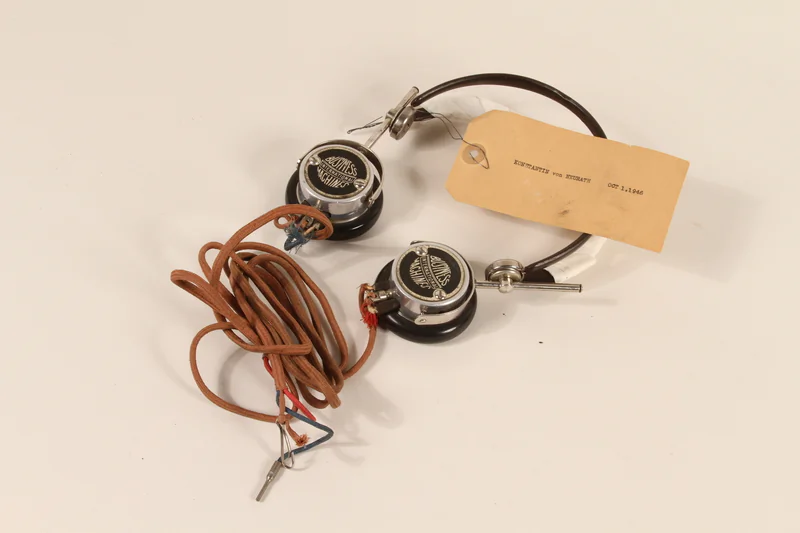Take a good look at these headphones. They were worn at the dawn of simultaneous interpreting, during the Nuremberg trials of 1945.
Notice the hard, heavy earpieces and flimsy wiring. One can almost hear the static that was certainly there when the microphones were muted in that courtroom. They don’t exactly scream ‘quality’. It would be fair to assume that concepts such as “frequency response” and “acoustic shock” were never considered by IBM in the design.
Yet despite their apparent flaws and battered looks, those headphones enabled prosecutors, defendants, witnesses and court reporters to get through ten months of meetings in the most unforgiving of settings. And with real-time interpretation in four languages at that.
The device did not meet any particular standard. Nothing in that courtroom did. The interpreters’ booths were not ISO-compliant either. The organization responsible for the ISO norms would only be created two years later, in 1947.
Standardizing the Field
In the 75 years since the trials, several ISO standards have been developed for simultaneous interpretation booths and the equipment that goes into them. Standards are also available on the quality of transmission of sound and image.
Now, with the advent of Remote Simultaneous Interpretation, a.k.a. RSI, the discussion around ISO standards is back and many questions are asked:

The website of ISO, the International Organization for Standardization, offers some insight.
As the most observant among you will notice, the ISO acronym doesn’t capture the organization’s name perfectly in English or any other language. Rather, it is derived from the Greek ‘isos’, meaning ‘equal’. That tells us that, in the adoption of a standard, consistency may trump quality.
Consider conference interpreting again. As simultaneous gradually replaced consecutive as the preferred mode of interpreting in multilingual conferences, the equipment and the physical installations required became the subject of greater attention.
New materials, new equipment, and new procedures were tried in a hit-and-miss approach. In time, the users and practitioners of the new service started to feel the need to level the playing field. Best practices slowly developed.
Standards are basically best practices and parameters agreed upon by “people with expertise in their subject matter” as ISO puts it. We are talking manufacturers, sellers, buyers, customers, trade associations, users or regulators.
Standards can be driven by a technology that hasn’t yet hit the market. Such ex-ante standards may prove useful in guiding future developments, but they must be approached cautiously. The risk of arriving at something conceptually wise that never finds a real-world application is always there.
Then again letting disruption alone lead the way can be useful under circumstances where no previous reference exists. But it also risks fragmenting the market around a dominant player whose vision may be detached from market needs.
Standards are a sign of maturity of a technology or process, in any field. But they cannot be imposed. Rather, they must be negotiated to reflect the best achievable result at a given point in time. Success hinges on the ability to gather everyone, incumbents and disruptors, around the table. It is an exercise in persuasion and compromise which cannot be done by proxy. Those with skin in the game need to roll up their sleeves and do the job.
That’s exactly what KUDO is doing
Fardad Zabetian, KUDO’s founder and CEO, is a subject matter expert for the American National Standards Institute (ANSI), with a seat at the ISO committee dealing with the nascent field of Remote Simultaneous Interpretation. Back in 2018, ANSI was the one proposing ISO/PAS 24019 as a new working item for the relevant committee.
The Publicly Available Specification, passed about a year later, established “the requirements and recommendations for using simultaneous interpreting delivery platforms in settings where the interpreters are, or are not, in the same room as participants and speakers at a communicative event.”
KUDO has since followed these developments with great interest, and it shows. Of the 16 core specifications listed in PAS 24019 on how sound and image should be handled by RSI systems, KUDO meets as many as 14, with another one on its way.
PAS 24019, soon to be enshrined as a full ISO standard, reflects the current status of RSI developments, as brought about by the collective endeavor of interpreters, technology providers, conference-goers, researchers, and other stakeholders.
Like the systems it attempts to standardize, the new ISO standard is a work in progress, with a few revisions expected over time. But the technology has proven its value.
To future generations, the solution we currently have will eventually look cumbersome. But we are as proud of it now as IBM once was of those headphones from Nuremberg.
Seventy-five years apart, and despite their apparent flaws or battered looks, both solutions have changed the world of interpreting significantly.
Perhaps permanently.
Would you like to see all these standards in action?
Want to learn how to prepare for your first multilingual web conference?
Check out the recipe for success
Tags include: global meetings, interpretation, interpreter


